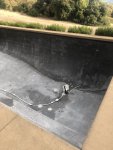We have a 20,000 gal in ground concrete/gunnite pool. Just before I left on sunday, I checked the pool chemistry and everything looked fine. Got back on Thursday and the pool was empty. Bone dry. A couple minor signs of dampness in the meadow below the pool but other than that, no sign of where the water went.
I originally assumed that the main drain pipe broke but it occurred to me that there could be a leak in one of the pipes feeding the jets. The pump would suck the water from the main drain and just pump it to oblivion. The bottom line is that I have no idea where the leak is. Are pool pipes and drains embedded in the concrete or do they just pierce the wall and run along the edge of the concrete?
We're in a rural area of N California wine country and our pool contractor closed up shop and retired. Finding a new contractor is going to be challenging since I suspect figuring out what happened and fixing it is going to require some real expertise. I've got a call into another pool company but I suspect their repair expertise is more in the area of pumps and filters.
Any advice would be appreciated.
At my darkest moment, I could imagine where the only viable option is to demolition the pool (11 years old) and start over.

I originally assumed that the main drain pipe broke but it occurred to me that there could be a leak in one of the pipes feeding the jets. The pump would suck the water from the main drain and just pump it to oblivion. The bottom line is that I have no idea where the leak is. Are pool pipes and drains embedded in the concrete or do they just pierce the wall and run along the edge of the concrete?
We're in a rural area of N California wine country and our pool contractor closed up shop and retired. Finding a new contractor is going to be challenging since I suspect figuring out what happened and fixing it is going to require some real expertise. I've got a call into another pool company but I suspect their repair expertise is more in the area of pumps and filters.
Any advice would be appreciated.
At my darkest moment, I could imagine where the only viable option is to demolition the pool (11 years old) and start over.

Last edited:

